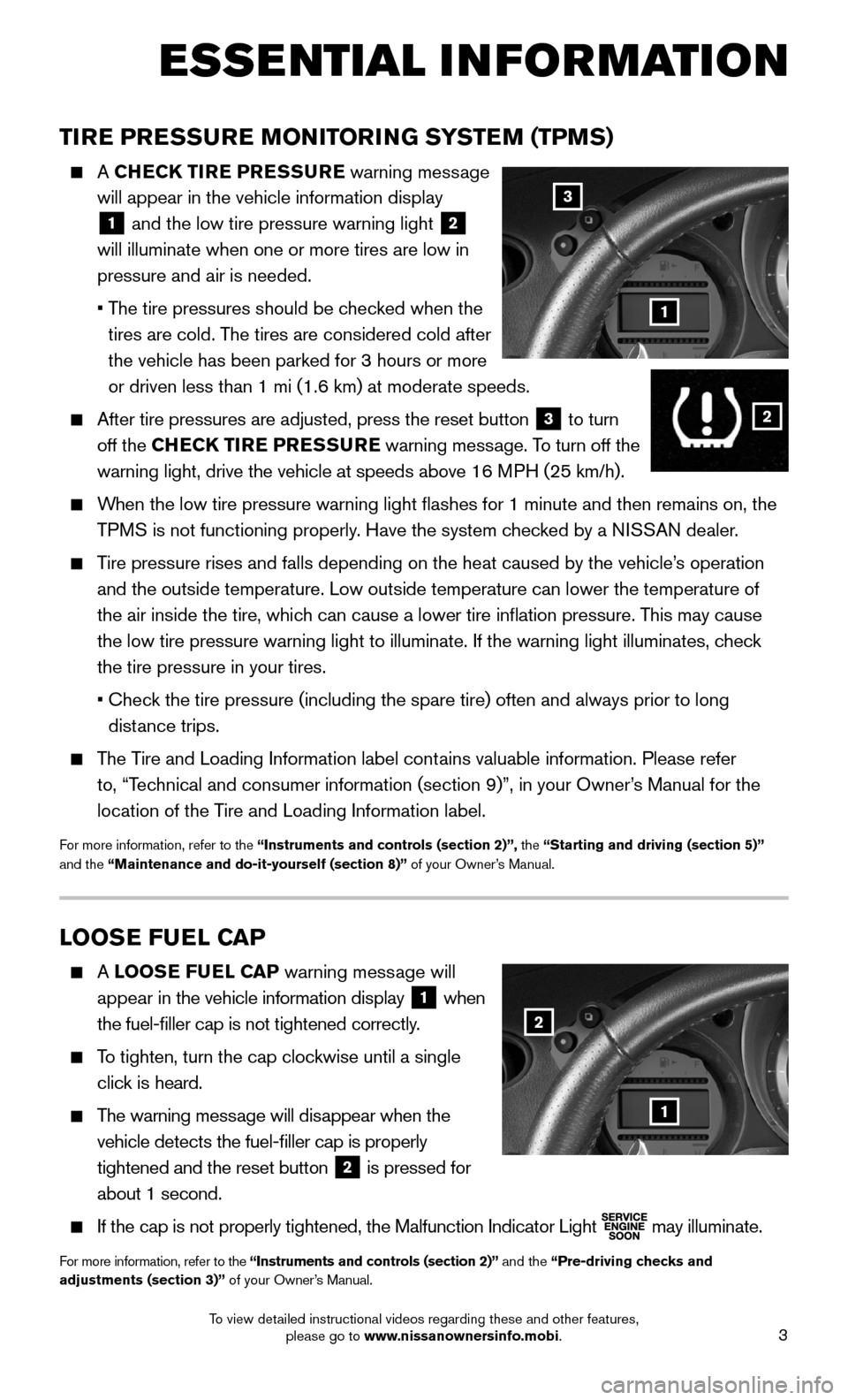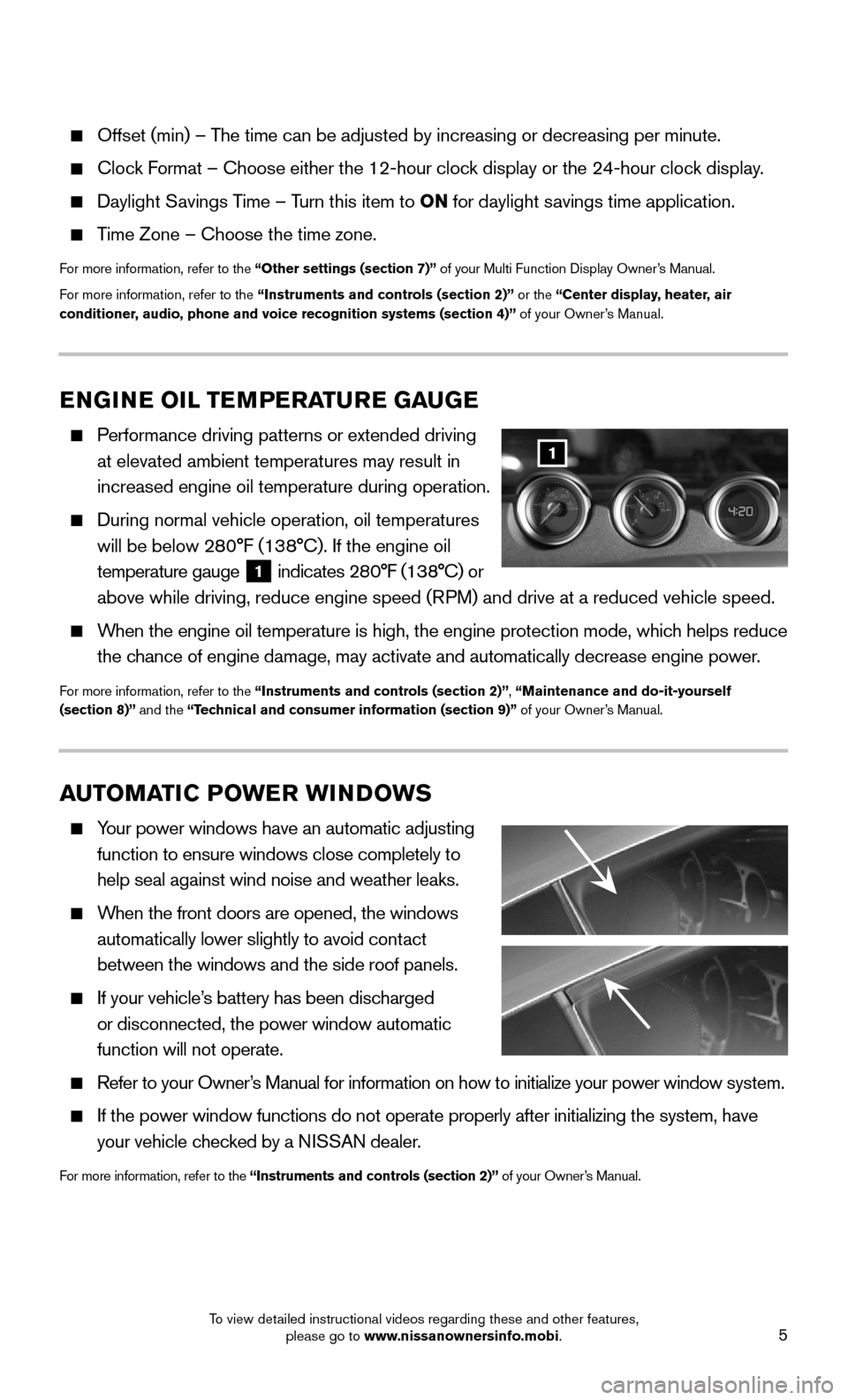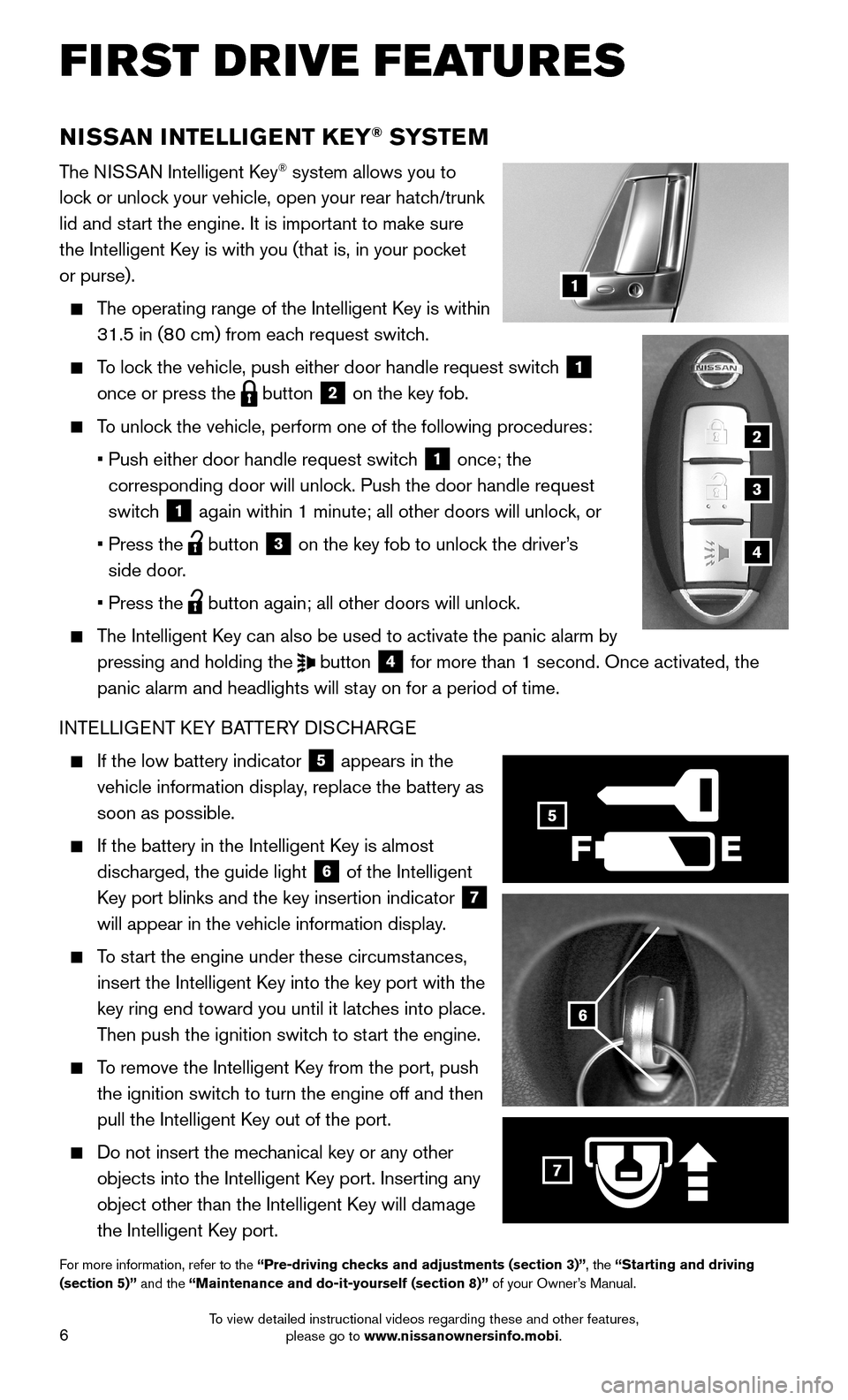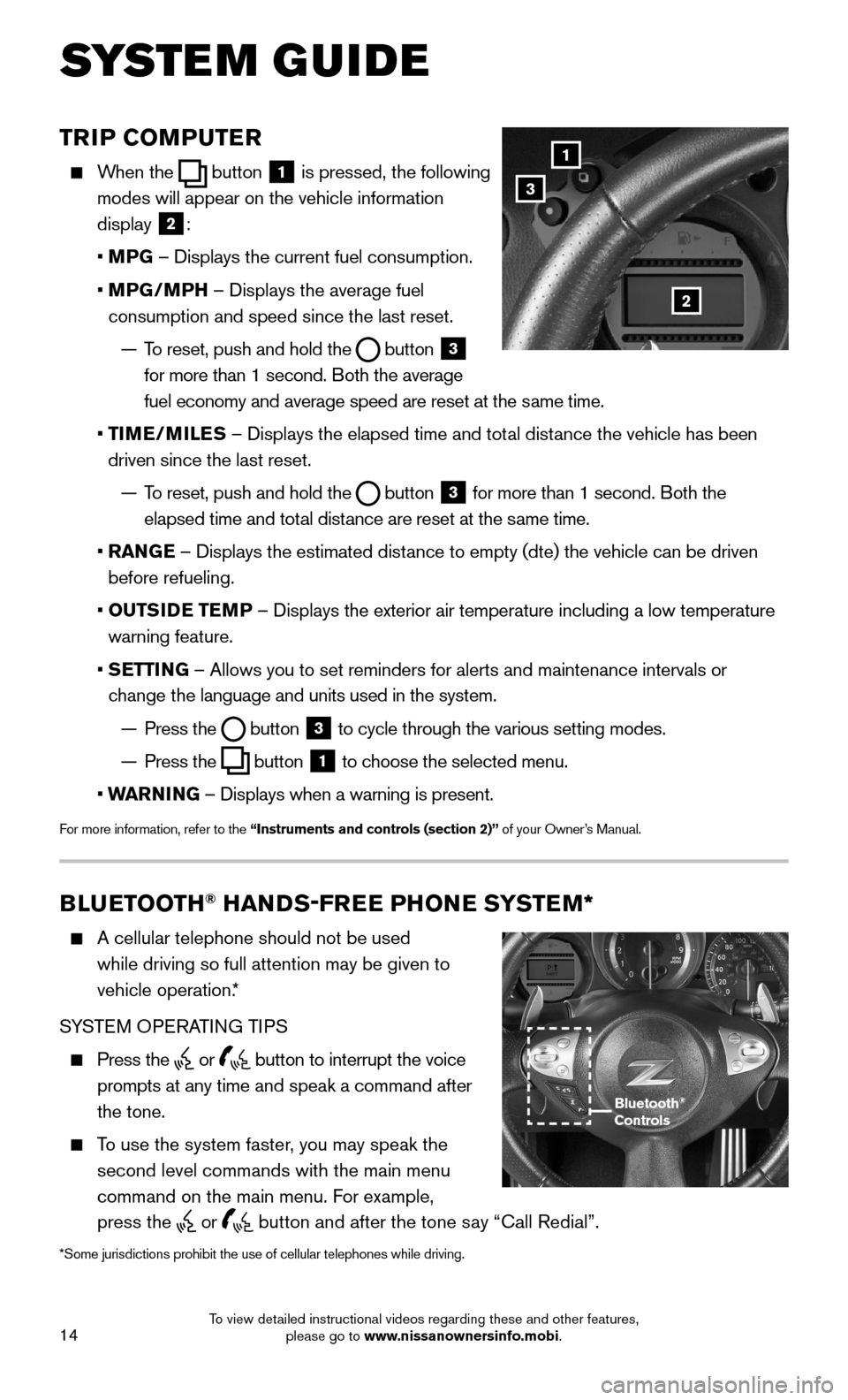2015 NISSAN 370Z COUPE maintenance
[x] Cancel search: maintenancePage 5 of 24

3
LOOSE FUEL CAP
A LOOSE FUEL CAP warning message will
appear in the vehicle information display 1 when
the fuel-filler cap is not tightened correctly.
To tighten, turn the cap clockwise until a single
click is heard.
The warning message will disappear when the
vehicle detects the fuel-filler cap is properly
tightened and the reset button 2 is pressed for
about 1 second.
If the cap is not properly tightened, the Malfunction Indicator Light may illuminate.
For more information, refer to the “Instruments and controls (section 2)” and the “Pre-driving checks and adjustments (section 3)” of your Owner’s Manual.
2
1
TIRE PRESSURE MONITORING SYSTEM (TPMS)
A CHECK TIRE PRESSURE warning message
will appear in the vehicle information display
1 and the low tire pressure warning light 2 will illuminate when one or more tires are low in
pressure and air is needed.
• The tire pressures should be checked when the
tires are cold. The tires are considered cold after
the vehicle has been parked for 3 hours or more
or driven less than 1 mi (1.6 km) at moderate speeds.
After tire pressures are adjusted, press the reset button 3 to turn
off the CHECK TIRE PRESSURE warning message. To turn off the
warning light, drive the vehicle at speeds above 16 MPH (25 km/h).
When the low tire pressure warning light flashes for 1 minute and then \
remains on, the
TPMS is not functioning properly. Have the system checked by a NISSAN dealer.
Tire pressure rises and falls depending on the heat caused by the vehicle\
’s operation
and the outside temperature. Low outside temperature can lower the tempe\
rature of
the air inside the tire, which can cause a lower tire inflation pressure. This may cause
the low tire pressure warning light to illuminate. If the warning light \
illuminates, check
the tire pressure in your tires.
• Check the tire pressure (including the spare tire) often and always prior \
to long
distance trips.
The Tire and Loading Information label contains valuable information. Please refer
to, “Technical and consumer information (section 9)”, in your Owner’s Manual for the
location of the Tire and Loading Information label.
For more information, refer to the “Instruments and controls (section 2)”, the “Starting and driving (section 5)” and the “Maintenance and do-it-yourself (section 8)” of your Owner’s Manual.
3
1
2
ESSE NTIAL I N FOR MATION
To view detailed instructional videos regarding these and other features, please go to www.nissanownersinfo.mobi.
Page 7 of 24

5
Offset (min) – The time can be adjusted by increasing or decreasing per minute.
Clock Format – Choose either the 12-hour clock display or the 24-hour clock display.
Daylight Savings Time – Turn this item to ON for daylight savings time application.
Time Zone – Choose the time zone.
For more information, refer to the “Other settings (section 7)” of your Multi Function Display Owner’s Manual.
For more information, refer to the “Instruments and controls (section 2)” or the “Center display, heater, air conditioner, audio, phone and voice recognition systems (section 4)” of your Owner’s Manual.
ENGINE OIL TEMPERATURE GAUGE
Performance driving patterns or extended driving
at elevated ambient temperatures may result in
increased engine oil temperature during operation.
During normal vehicle operation, oil temperatures
will be below 280°F (138°C). If the engine oil
temperature gauge 1 indicates 280°F (138°C) or
above while driving, reduce engine speed (RPM) and drive at a reduced vehicle speed.
When the engine oil temperature is high, the engine protection mode, whic\
h helps reduce
the chance of engine damage, may activate and automatically decrease engine p\
ower.
For more information, refer to the “Instruments and controls (section 2)”, “Maintenance and do-it-yourself (section 8)” and the “Technical and consumer information (section 9)” of your Owner’s Manual.
1
AUTOMATIC POWER WINDOWS
Your power windows have an automatic adjusting
function to ensure windows close completely to
help seal against wind noise and weather leaks.
When the front doors are opened, the windows
automatically lower slightly to avoid contact
between the windows and the side roof panels.
If your vehicle’s battery has been discharged
or disconnected, the power window automatic
function will not operate.
Refer to your Owner’s Manual for information on how to initialize your power window system.
If the power window functions do not operate properly after initializing\
the system, have
your vehicle checked by a NISSAN dealer.
For more information, refer to the “Instruments and controls (section 2)” of your Owner’s Manual.
To view detailed instructional videos regarding these and other features, please go to www.nissanownersinfo.mobi.
Page 8 of 24

6
FIRST DRIVE FEATURES
NISSAN INTELLIGENT KEY® SYSTE M
The NISSAN Intelligent Key® system allows you to
lock or unlock your vehicle, open your rear hatch/trunk
lid and start the engine. It is important to make sure
the Intelligent Key is with you (that is, in your pocket
or purse).
The operating range of the Intelligent Key is within
31.5 in (80 cm) from each request switch.
To lock the vehicle, push either door handle request switch 1 once or press the button 2 on the key fob.
To unlock the vehicle, perform one of the following procedures:
• Push either door handle request switch 1 once; the
corresponding door will unlock. Push the door handle request
switch 1 again within 1 minute; all other doors will unlock, or
• Press the button 3 on the key fob to unlock the driver’s
side door.
• Press the button again; all other doors will unlock.
The Intelligent Key can also be used to activate the panic alarm by
pressing and holding the button 4 for more than 1 second. Once activated, the
panic alarm and headlights will stay on for a period of time.
INTELLIGENT KEY BATTERY DISCHARGE
If the low battery indicator 5 appears in the
vehicle information display, replace the battery as
soon as possible.
If the battery in the Intelligent Key is almost
discharged, the guide light 6 of the Intelligent
Key port blinks and the key insertion indicator 7 will appear in the vehicle information display.
To start the engine under these circumstances,
insert the Intelligent Key into the key port with the
key ring end toward you until it latches into place.
Then push the ignition switch to start the engine.
To remove the Intelligent Key from the port, push
the ignition switch to turn the engine off and then
pull the Intelligent Key out of the port.
Do not insert the mechanical key or any other
objects into the Intelligent Key port. Inserting any
object other than the Intelligent Key will damage
the Intelligent Key port.
For more information, refer to the “Pre-driving checks and adjustments (section 3)”, the “Starting and driving (section 5)” and the “Maintenance and do-it-yourself (section 8)” of your Owner’s Manual.
6
F
5
7
2
3
4
1
To view detailed instructional videos regarding these and other features, please go to www.nissanownersinfo.mobi.
Page 16 of 24

14
TRIP COMPUTER
When the button 1 is pressed, the following
modes will appear on the vehicle information
display 2:
• MPG – Displays the current fuel consumption.
• MPG/MPH – Displays the average fuel
consumption and speed since the last reset.
— To reset, push and hold the button 3 for more than 1 second. Both the average
fuel economy and average speed are reset at the same time.
• TIME/MILES – Displays the elapsed time and total distance the vehicle has been
driven since the last reset.
— To reset, push and hold the button 3 for more than 1 second. Both the
elapsed time and total distance are reset at the same time.
• RANGE – Displays the estimated distance to empty (dte) the vehicle can be driven
before refueling.
• OUTSIDE TEMP – Displays the exterior air temperature including a low temperature
warning feature.
• SETTING – Allows you to set reminders for alerts and maintenance intervals o\
r
change the language and units used in the system.
— Press the button 3 to cycle through the various setting modes.
— Press the button 1 to choose the selected menu.
• WARNING – Displays when a warning is present.
For more information, refer to the “Instruments and controls (section 2)” of your Owner’s Manual.
1
3
2
BLUETOOTH® HANDS-FREE PHONE SYSTEM*
A cellular telephone should not be used
while driving so full attention may be given to
vehicle operation.*
SYSTEM OPERATING TIPS
Press the or button to interrupt the voice
prompts at any time and speak a command after
the tone.
To use the system faster, you may speak the
second level commands with the main menu
command on the main menu. For example,
press the or button and after the tone say “Call Redial”.
Bluetooth® Controls
SYSTEM GUIDE
*Some jurisdictions prohibit the use of cellular telephones while drivin\
g.
To view detailed instructional videos regarding these and other features, please go to www.nissanownersinfo.mobi.